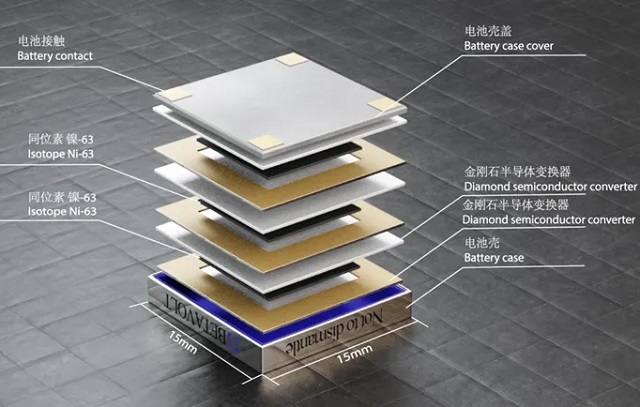- cross-posted to:
- [email protected]
- [email protected]
- cross-posted to:
- [email protected]
- [email protected]
innovative new power source that combines nickel-63 isotope decay and China’s first diamond semiconductor module. This integration allows the battery to be dramatically miniaturized while maintaining low production costs.
So the diamond semiconductor is the innovation?
At its core is the company’s unique ability to dope diamond, the holy grail of semiconductors, into large wafers only 10 micrometers thin. This enables the radioactive nickel to efficiently convert its decay into electricity.
Ahh… nifty.
Downside is… if these start getting used in “consumer” products… that seems like there are gonna be problems with radioactive stuff concentrating in landfills and seat cushions and stuff.
Furthermore, atomic batteries are environmentally friendly. After the decay period, the radioactive source nickel-63 isotope transforms into stable copper isotopes, posing no threats, hazards, or pollution to the environment. Consequently, nuclear batteries do not require expensive recycling processes like existing chemical batteries
Well… that answers the previous issue.
Ah yes, science journalism is pretty bad no matter who’s making the science. At least it’s not all signaphobic and crap.
But it starts off talking about the Terminator. Weird. And then it mentions that these batteries can be used in AI applications at every opportunity that they could. But these would be terrible for AI applications! AI takes a ton of energy.
But we’ve been using radioactive batteries in niche applications for years, and this is a great innovation in that space. Low-powered satellites and things like that might see a lot of use of these!
Yeah, science reporting continues to be terrible, but I do think that there could be a lot of neat applications for these kinds of batteries especially as chips get smaller. There’s Koomey’s law that’s an observation that the number of computations per joule of energy dissipated doubled about every 1.57 years. Basically, to make chips faster we have to make them smaller, and that in turn means they use less energy. Batteries that trickle a bit of energy could power chips that can do a lot of computation going forward.
That’s a fair point. I’m not sure where the power usage will bottom out, but low-powered devices might get useful fairly soon.
Theoretically in the insanely far future we could eventually have computers that require no external energy to process things. The way transistors work now is that to turn a 0 into a 1 you input an electron and to turn a 1 back to a 0 you dump it out as heat. If you were instead to move that electron around losslessly then you would only need enough external power to cover any unideal components, if there are any. Of course such a thing would require a fundamental redesign on how computers work internally, but seeing as how similar research has been undergone for quantum computing i’m not going to be surprised if some space communist society finds a way to make it work.
I think in a more observable future we’ll likely start seeing chips that can be powered by ambient wifi signals. I can see that happening within the next couple of decades, especially if some new substrates such as this come to market https://www.scmp.com/news/china/science/article/3232116/revolutionising-semiconductor-industry-chinese-scientists-unveil-12-inch-wafer-groundbreaking-2d
“AI is a hot topic. let’s bring that up!”

Imagine not needing to charge stuff.
gonna need that for our power armor.
Fallout: Chinese copied superior Usian tech!
Real life: lol
They really said that? Man that fucking sucks.
Yeah, it appears only in Fallout 76 and there Chinese power armor is “attempt” to copy of the standard Usian one.
Lol of course it’s the fascist open world microtransactions one.
To the town Beijing China rode a stranger one fine day🎶
Why? They could have gotten more than thrice the Wattage for the same rate if they visited the hundreds of thousands of Holocaust victims who are spinning in their graves right now because of Zionists.
😄
These kinds of batteries have been around for ages, they produce microwatts. They are really useful in niche applications, but anything the media ever says about them is wrong and misleading.
Seems cool, but I would bet that it will never see a true consumer application. The amount of radioactive material you would need for the proposed 1 watt version is too much to mass produce and sell - this aint the Fallout universe.
But at what cost…?
In the west, it would be several $billion. To buy the patent and hide it in a safe, cast in concrete, and bury the blueprints underground for another fifty years to keep the world reliant on oil.
First thought: Is this just another RTG model? I’ve worked in that field. They’ve been around a long time. They power satellites, etc. They’re expensive, heavy and inefficient.
Second though: Oh, they’re going with direct electron capture. That’s neat. I don’t know much about those. Carbon/diamond as a capture material is good and cheap.
FTA:
The nuclear battery generates power every second and minute, producing 8.64 joules of energy per day and 3,153 joules of energy per year.
That’s not how radioactive decay works. I mean, yeah, the half life is 100 years, so this is pretty stable, but it’s gonna go down. (Incidentally, daughter products are Cu63 (stable) and an electron.)
Also, you do NOT want radio isotopes floating out in the wild. Watch any of Plainly Difficult’s videos on nuclear incidents and it’s not good.
It’s a betavoltaic, it’s an established technology but not yet commercialized. There was a scam/grift nuclear battery startup that used a similar system except they were making wildly extravagant claims, going as far as to literally lie about the output right next to the example picture which showcased the actual power output printed on the side of the device. It’s a really cool concept but of course they had to fuck it up by being blatant charlatans. Oh well, at least China is here once again to pick up the slack from America’s failings.
I’m sure this is definitely as cool as it sounds and not alphabet soup spilled over by a slackjawed “journalist”
I am weary of it solely because it seems too good to be true but on the other hand can we hurry up with smart phones that never need to be charged?
Also though I have to wonder, could these be used in things that aren’t using power all the time? Like, lots of devices use power intermittently. What happens to the excess energy when the battery isn’t in use? Just dissipates? Or would you simply not use these batteries for such an application?
smart phones that never need to be charged
Well with an average consumption of maybe half a Watt over the course of a day, you would need 5000 of these to power your phone given they put out 100 microWatts.
Didn’t they say in the article they had plans to release a 1watt battery in 2025? I’ll be honest, I’m not good with electricity. lol
They did, but from the sounds of it I’m guessing they’re just gonna be a physically bigger one. This is a very very small battery, but produces very little energy. But easy enough to just slap a few of them together.
Unfortunately, it doesn’t change the power density or anything like that.
This specific technology will never be in charge of running a smartphone or anything like that. But maybe a tweak or innovation on these radioactive batteries could get them to be a few watts and you could get a super low-powered cell phone device that could be used in emergencies only and last for like 50 years.
The average telephone uses 4.5-11 watts of energy a day. 0.5 is barely anything, flip phones maybe used that much 20 years ago.
You’re conflating Watt-hours and Watts. Watts are a measure of power, which is energy consumption per unit time. Watt-hour is power multiplied by time, the time cancels and so it’s a measure of energy. 0.5 Watts for an entire day adds up to 12 Watt-hours in a day, which is a reasonable estimate for a phone battery.
My bad! You’re right!
I always hated electrical engineering and it was by far my worst subject. Sorry for not being very knowledgeable with it, thanks for the correction!
.5? The article said 100 microwatts so .0001 watts.
So wayyy worse than that.
With how people play games on phones, they would chew those batteries like candy.
My guess is that excess power is just going to keep on building up until the voltage gets high enough that its self-discharge surpasses its generation capacity and effectively turns any excess energy generated directly into heat.
I can’t get excited about .0001 watts.
A potato battery produces about 10 times more.
Yawwwwwwwn
“They are very costly, but have an extremely long life and high energy density, and so they are typically used as power sources for equipment that must operate unattended for long periods of time, such as spacecraft, pacemakers, underwater systems and automated scientific stations in remote parts of the world.”
China achieves scientific breakthrough
Westoid copes












